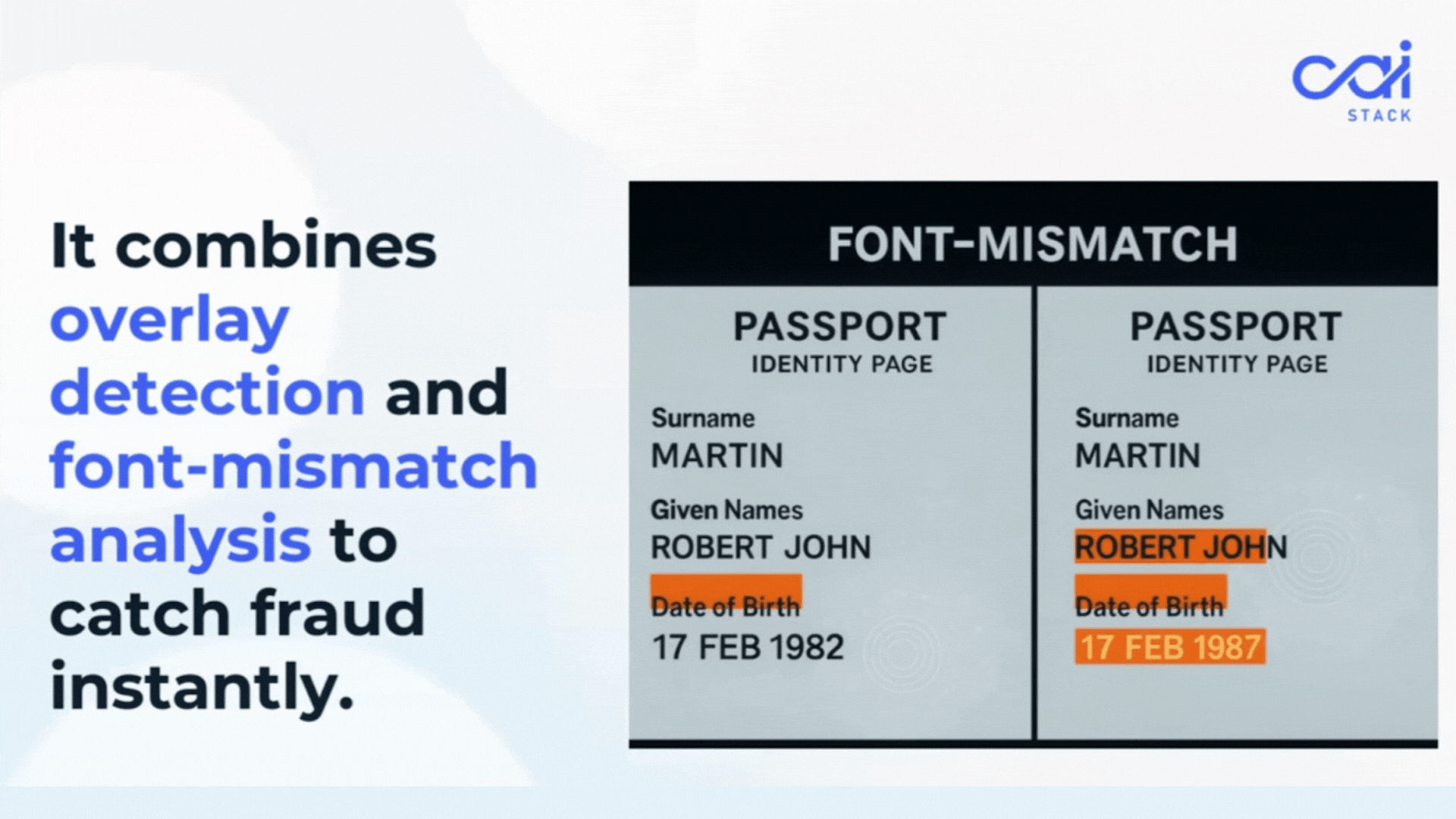CAIStack Team
Document fraud detection is keeping compliance teams up at night. We get it.
You're processing thousands of customer documents daily. Driver's licenses, passports, bank statements, and utility bills. Each one needs verification before you can onboard that customer.
Forged documents account for over 50% of all identity fraud attempts, according to the recent Fraud Report. And the problem is growing; it was found that digital document forgeries surged 244% in 2024, with 57% of all document fraud now being AI-powered or digitally manipulated.

But here's the problem: Traditional OCR just reads text. It doesn't understand what it's reading.
That gap between reading and understanding? That's where fraudsters slip through.
Let me paint you a picture.
Your current OCR system scans a driver's license. It accurately extracts the name "John Smith" and the date of birth "01/15/1985". The text is clean, readable, and matches your database requirements.
Case closed, right? Wrong.
Classic OCR tools are like having an excellent typist who can't spot a fake Rolex. And those blind spots are expensive.

Businesses report average losses of $300,000 per fraud incident. Worse, fraudsters are increasingly using tools that cost as little as $1,000 or sometimes free AI tools to create fake documents capable of bypassing standard OCR systems, generating up to $2.5 million in monthly fraud-related losses.
They'll transcribe every detail perfectly while missing the obvious red flags.
The cost of this blind spot?
Document-based identity fraud represents a significant portion of business losses across industries. Most of these cases involve documents that pass basic OCR validation but fail deeper inspection.
These AI systems aren’t just reading, they’re interpreting. The report shows that 99.7% accuracy can be achieved in detecting AI-powered document fraud. This enables organizations to cut manual review time by over 90% and reduce fraud risk by up to 40%.
Here's where intelligent document processing steps in.
Modern AI systems don't just read documents. They analyze them like a forensic expert would.
What makes AI-powered OCR different:
Think of it as the difference between a photocopier and a detective.
Let's say someone submits a utility bill for address verification. Standard OCR reads the address and amount due. AI-powered systems go deeper:
CAI Stack worked with a fintech company that was struggling with document fraud. Their traditional OCR system had excellent accuracy for text extraction.
Sounds good, right?
But their fraud detection capabilities were limited. They were reading documents perfectly while missing obvious fakes.
After implementing AI-powered document intelligence, their results improved significantly:
The AI system caught patterns that their human reviewers missed. Subtle inconsistencies in document formatting. Unusual combinations of supporting documents. Geographic anomalies in document origins.
Ready to see how AI-powered document intelligence works for your business? Book a free demo with CAI Stack to explore how intelligent document processing can reduce fraud while improving your onboarding process.
Let's get technical for a moment, but not too technical.
Computer vision forms the foundation. The AI doesn't just convert images to text. It analyzes pixel patterns, color variations, and structural elements.
Machine learning models trained on millions of legitimate documents create baseline expectations. When a document deviates from these patterns, the system flags it for review.
Natural language processing adds another layer. It checks if the extracted information makes logical sense. Does the address format match the claimed country? Is the signature style consistent across multiple documents?
Database integration provides real-time verification against official sources and known fraud patterns.
Here's what this looks like in practice
The entire process takes seconds, not days.
Most companies think automation means higher risk. That's traditional thinking.
Manual document review is inconsistent. Your team gets tired. They miss details. Different reviewers have different standards.
Research shows that combining NLP and behavioral biometrics can improve outcomes: account takeover fraud is reduced by 66%, and document fraud detection accuracy improves by up to 60% in insurance and finance sectors.
Intelligent automation creates consistent, thorough verification every single time.
But here's the crucial part: The AI doesn't replace human judgment. It enhances it.
High-confidence approvals go through automatically. Edge cases get flagged for human review with the detailed analysis already complete. Your team focuses on complex decisions instead of routine checks.
This technology is evolving fast.
Companies that invest in document intelligence now will have significant advantages as regulations tighten and fraud techniques become more sophisticated.
Document fraud detection isn't just about technology. It's about balance.
You need systems that catch fraudsters without frustrating legitimate customers. Speed without sacrificing security. Automation without losing human oversight.
AI-powered OCR and intelligent document processing make this balance possible.
Traditional OCR reads documents. AI-powered systems understand them.
That understanding is what keeps fraudsters out while letting good customers in.
Your compliance team can sleep better. Your customers get faster approvals. Your business reduces risk as it scales operations.
Want to see how document intelligence can improve your onboarding process? Schedule a free consultation with CAI Stack and discover how AI-powered document fraud detection can streamline your verification process while enhancing security.
Subscribe to get the latest updates and trends in AI, automation, and intelligent solutions — directly in your inbox.
Explore our latest blogs for insightful and latest AI trends, industry insights and expert opinions.
Empower your AI journey with our expert consultants, tailored strategies, and innovative solutions.